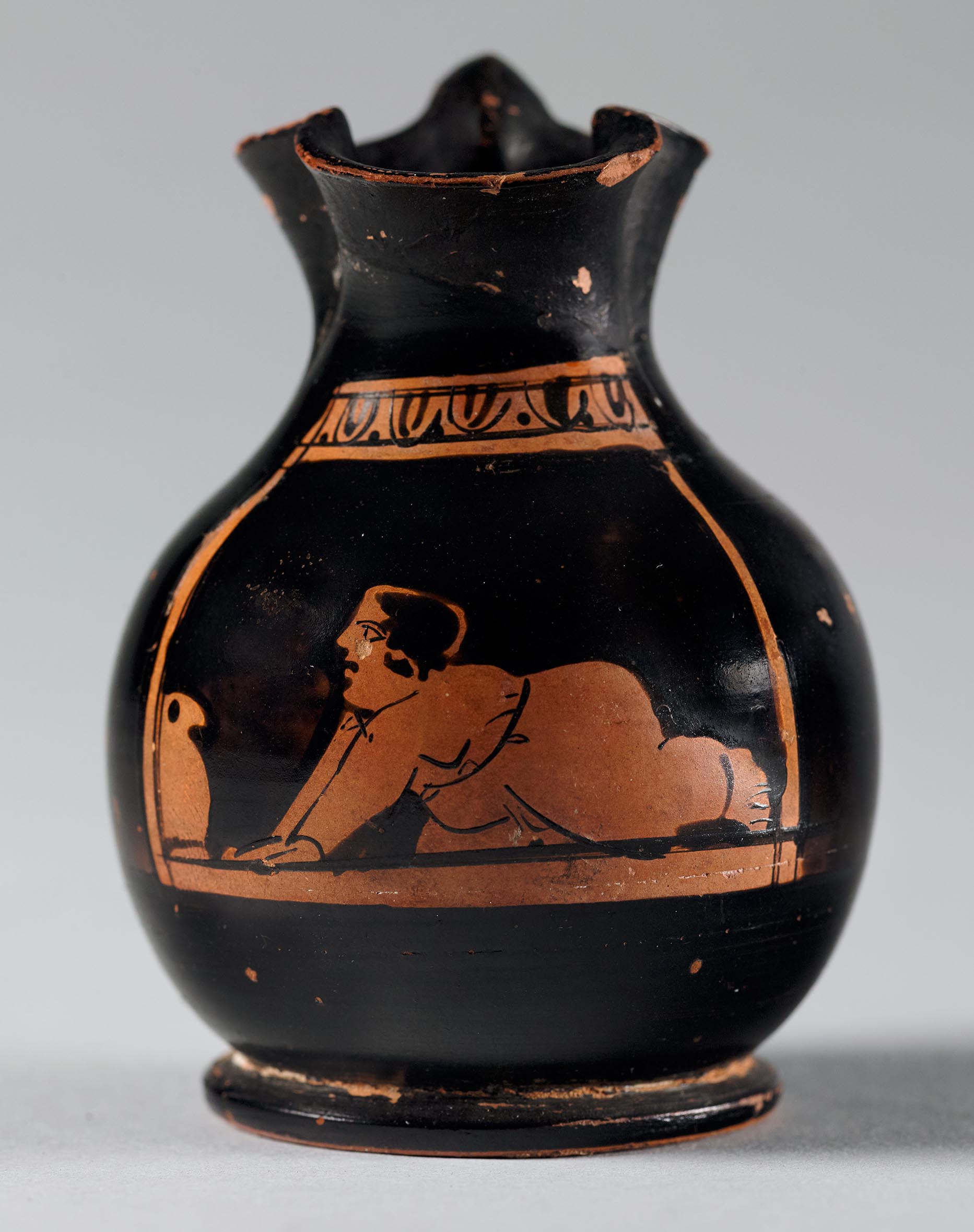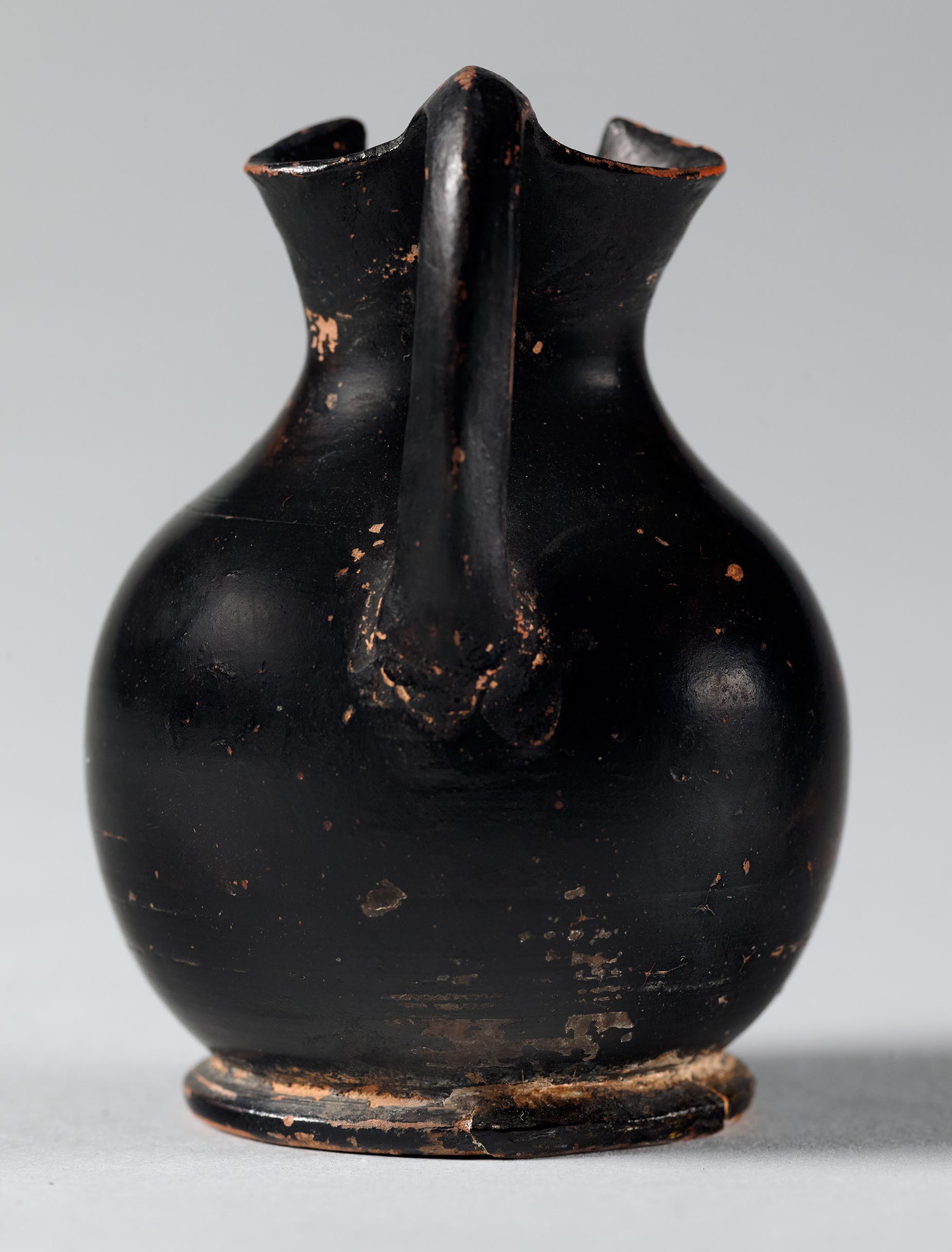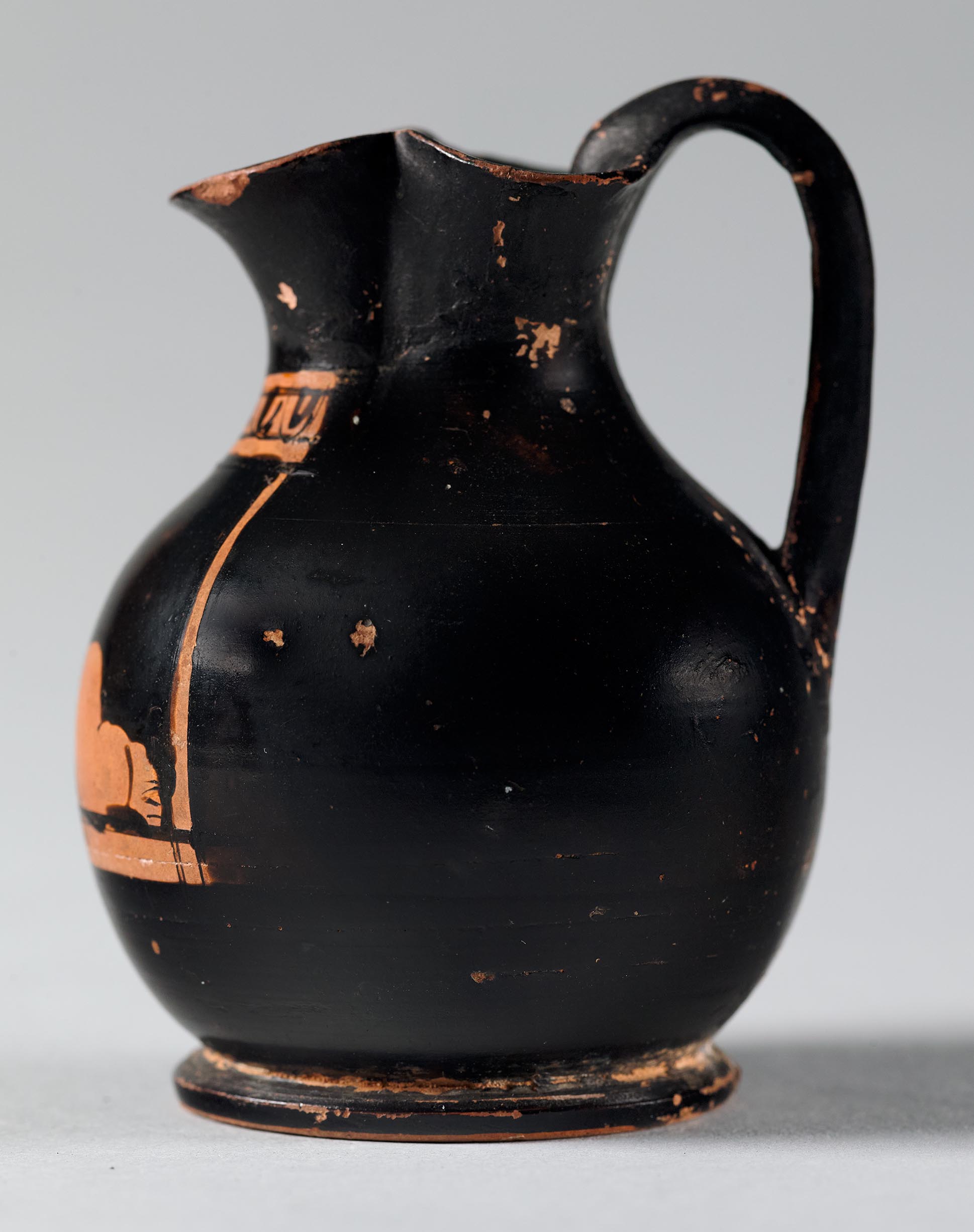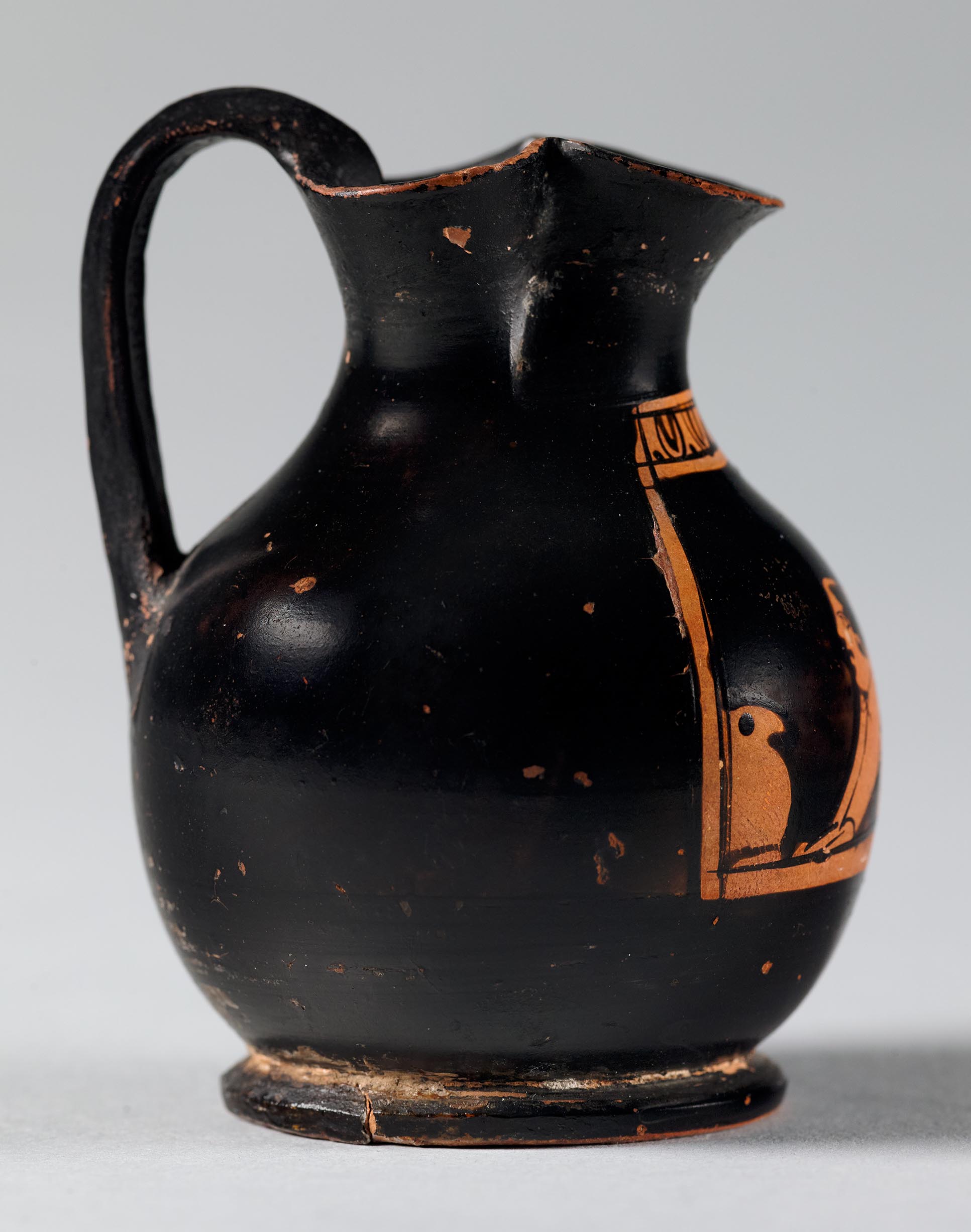Provenance
Ex collection Franz von Matsch (Vienna); 1953, sale, Parke-Bernet Galleries (New York, NY) to Princeton University.
Shape and Ornament
Miniature in size, with continuous curve from mouth to foot. Trefoil mouth surmounting a short neck. Interior of neck black. Ridged handle, black, triangular in section. Figural panel framed above by ovolo, and at the sides and bottom by simple reserved bands. Low ring base; underside reserved.
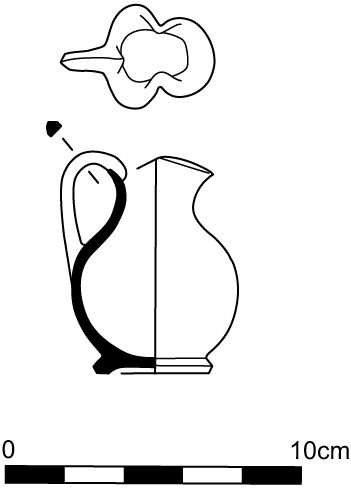
Subject
Chubby child in profile crawling to the left. The nude child crawls toward a jug on the ground, possibly a chous, which is overlapped by the frame of the panel. His mouth is open, and his head is held vertically. The baby’s arms are straight, with his palms pressed against the ground. His right knee is tucked underneath his body as he moves forward, while his left leg and foot extend behind him, the former slightly flexed. The baby wears a girdle of amulets across his chest.
Attribution and Date
Attributed to the Crawling Boy Workshop [J. R. Green]. Circa 420 BCE.
Dimensions and Condition
h. 7.5 cm; diam. 5.6 cm; diam. of mouth (lateral) 3.5 cm; diam. of mouth (back to front) 3.1 cm; diam. of foot 4.2 cm. Small losses of black gloss throughout. Sections of the foot restored.
Bibliography
CVA Vienna 1 (Germany 5) 15, pl. 8.9; G. van Hoorn, Choes and Anthesteria (Leiden, 1951), 192, no. 988; Parke‑Bernet Galleries, Egyptian, Greek and Roman Art; Gothic & Renaissance Art, auc. cat., January 15, 1953, New York, NY, lot 83; F. F. Jones, “A Miniature Jug,” Abbreviation: Princeton RecordRecord of the Princeton University Art Museum. (1942– ). 12 (1953): 37; J. R. Green, “Some Alterations and Additions to van Hoorn ‘Choes and Anthesteria’ (Leiden, 1951),” Abbreviation: BICSBulletin of the Institute of Classical Studies of the University of London 8 (1961): 27, no. 91; id., “Choes of the Later Fifth Century,” Abbreviation: BSABritish School at Athens Annual (1971): 216; Abbreviation: Neils and Oakley, Coming of AgeNeils, J., and J. H. Oakley. 2003. Coming of Age in Ancient Greece: Images of Childhood from the Classical Past. Exhibition catalogue. Hood Museum of Art, Dartmouth College. Hanover, NH., 146 [illus.], 285, no. 96; J. H. Oakley, A Guide to Scenes of Daily Life on Athenian Vases (Madison, WI, 2020), 34, fig. 1.36; Abbreviation: BAPDBeazley Archive Pottery Database. http://www.beazley.ox.ac.uk 12517.
Comparanda
For the Crawling Boy Workshop, see Green, “Choes,” 213–20. Green (“Choes,” 215–16) lists Princeton’s oinochoe under the Class of the Copenhagen Choes, a subsection of the larger workshop distinguished from other late fifth-century oinochoai by their globular body, drawn-up mouth, and low ring base: cf. Copenhagen 10120 (Green, “Choes,” pl. 33c; Abbreviation: BAPDBeazley Archive Pottery Database. http://www.beazley.ox.ac.uk 1370). Princeton’s oinochoe is one of the larger from the class, which are on average around 7 cm in height.
For the drawing, cf. Athens 1556 (L. Deubner, Attische Feste [Berlin, 1932], pl. 29.1; van Hoorn, Choes and Anthesteria, 66, no. 51), which van Hoorn, and Neils and Oakley consider to be by the same hand (Abbreviation: Neils and Oakley, Coming of AgeNeils, J., and J. H. Oakley. 2003. Coming of Age in Ancient Greece: Images of Childhood from the Classical Past. Exhibition catalogue. Hood Museum of Art, Dartmouth College. Hanover, NH., 285, n. 96). Cf. also Copenhagen 10121 (van Hoorn, Choes and Anthesteria, fig. 538, no. 486; Abbreviation: BAPDBeazley Archive Pottery Database. http://www.beazley.ox.ac.uk 1369).
Beginning with the studies of Deubner (Attische Feste) and van Hoorn (Choes and Anthesteria), choes and their iconography have almost invariably been associated with the Anthesteria, a three-day Athenian wine festival in honor of Dionysos. The second day of the festival was called Choes and involved drinking contests, including one in which participants sat in silence and drained a full chous of wine. Following the example of Deubner and van Hoorn, subsequent scholars have attempted to use the imagery of choes to re-create features of the festival not found in the literary testimony: see, e.g., H. Rühfel, Kinderleben im klassischen Athen: Bilder auf klassischen Vasen (Mainz, 1984). The iconography of miniature choes, like Princeton’s, concentrates on the lives of infants and small children. It has been argued that as part of the Anthesteria children between three and four years of age were crowned with flowers and given these miniature jugs as gifts: see J. Bažant, “The Iconography of the Choes Reconsidered,” Listy Filologické 98 (1975): 72–78; M. Stern, “Kinderkännchen zum Choenfest,” in Thiasos: Sieben archäologische Arbeiten, Castrum Peregrini 132–33 (Amsterdam, 1978): 27–37; Rühfel, Kinderleben, 131–46; Abbreviation: Neils and Oakley, Coming of AgeNeils, J., and J. H. Oakley. 2003. Coming of Age in Ancient Greece: Images of Childhood from the Classical Past. Exhibition catalogue. Hood Museum of Art, Dartmouth College. Hanover, NH., 145–46. For the connection between the miniature size of the chous and the age of the child depicted on the vessel, see Bažant, “Iconography of Choes,” 72–78; Stern, “Kinderkännchen,” 31; Abbreviation: Neils and Oakley, Coming of AgeNeils, J., and J. H. Oakley. 2003. Coming of Age in Ancient Greece: Images of Childhood from the Classical Past. Exhibition catalogue. Hood Museum of Art, Dartmouth College. Hanover, NH., 145.
Since crawling babies should be considerably younger than three years old and since most of the children on choes are not shown in the act of crowning, it is possible that the scenes on choes do not refer to the official crowning of children during the Anthesteria but were simply gifts to children of a wider range of ages. For the argument that scenes of children on choes do not represent the official proceedings of the festival but rather contained veiled references, such as a depicted chous, to future Choes contests in which the baby will participate, see R. Hamilton, Choes and Anthesteria: Athenian Iconography and Ritual (Ann Arbor, MI, 1992), 113–22. Many of the miniature choes have been found in children’s graves in Athens, and it has been speculated that they were provided for children who died before they could participate in the festival, perhaps explaining the discrepancy between the age of the child depicted and the age at which the crowning of children took place at the Anthesteria: see A. Rumpf, “Attische Feste–Attische Vasen,” Abbreviation: BJbBonner Jahrbücher 161 (1961): 208–14; Green, “Choes,” 189; Rühfel, Kinderleben, 125–74. For maturation rites in Greek art, see Abbreviation: Smith, Religion in the ArtSmith, T. J. 2021. Religion in the Art of Archaic and Classical Greece. Philadelphia: University of Pennsylvania Press., 236–40.
The production of small choes was limited to between the last quarter of the fifth century and the first quarter of the fourth century, although the Anthesteria festival was fully developed long before the end of the fifth century. For a link between the Peloponnesian War and the production of small choes as part of a cultic response to a social crisis, see G. L. Ham, “The Choes and Anthesteria Reconsidered: Male Maturation Rites and the Peloponnesian Wars,” Bucknell Review 43, no. 1 (1999): 201–18.
